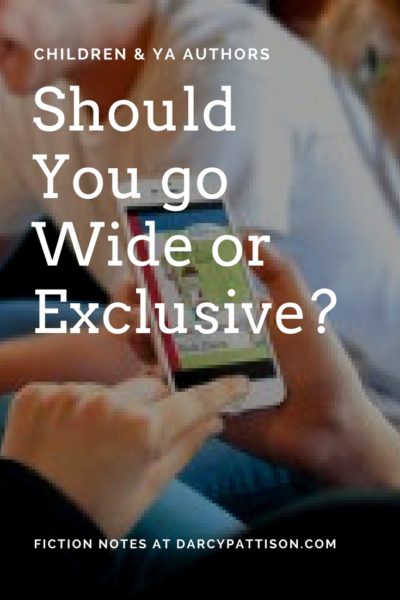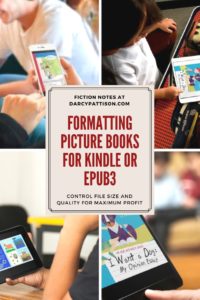In the indie book world, the debate still rages over ebook distribution: should I go wide or go exclusive with KU? KU is the Kindle Select program from Amazon which allows access to certain marketing tools in return for exclusivity.
Should Children/YA Authors Go Wide or Exclusive with KU?

I’ve been studying the issue and David Gaughran has interesting things to say. In his post, A Tale of Two Marketing Systems, he emphasizes that the two approaches are equally valid, but take different marketing systems. His 3rd edition of his classic book, Let’s Get Digital comes out later this month. [amazon_link asins=’B078ZNWD61′ template=’ProductAd’ store=’patty0d-20′ marketplace=’US’ link_id=’e3c9b514-0118-11e8-b6b9-e11963cc260e’]
In brief, Gaughran argues that the most important thing Amazon has done is create a new business model. They make sure that they display the books that are most likely to be bought. In traditional bookstores, publishers would pay for shelf space and they were guaranteed the prime spots in a store: front of the store, end caps, and so on. The price to enter such an advertising system was too high for most indie authors. But Amazon, Gaughran says, is neutral toward publishers; they don’t care if a book is self-published or from a traditional publisher. What Amazon prioritizes is a sale. It doesn’t have to be a big sale, because a $0.99 sale is fine.
In that neutral environment, then, smart and nimble self-publishers have thrived because they’ve figured out how to play within Amazon’s algorithms.
Going wide versus going exclusive is more about marketing. Wide means a slower growth with fewer spikes; it means developing your mailing list and reaching out wide. Going KU/exclusive means learning Amazon’s marketing engine and playing it to the hilt.
What business model? B2B or B2C
In the context of thinking about all of this, I’ve also had a shift of understanding. What people say about self-publishing is that authors can finally take their books direct to the readers.
Not exactly.
B2B means a business is selling to another business. B2C means that a business is selling straight to customers.
Self-publishers are actually B2B, although some authors have a strong B2C component. Most authors are NOT selling directly to their customers. They don’t sell in person or even through their websites. Instead, their books are available at Amazon and possibly other online bookstores. These authors must play by the retailer’s rules, and Amazon has strict rules!
Some authors, for sure, develop mailing lists that send sales to the retailers. I’ve heard of authors with 50,000+ people on a mailing list. When they send out a message, they can generate huge sales. Despite this strong B2C component, they are still a B2B business because they aren’t selling directly to the reader, but are instead, sending readers to the retailers.
Why does that matter? Because the two business strategies are different. A B2B business typically develops close ties with key personnel at the other company. Do you have a Kindle rep? Most of us don’t, and most of us will never generate enough sales to get one.
If you’re a B2C business, then you concentrate on pleasing the customer. You know who your customers are (or you should!). When authors drag their feet about setting up a mailing list, they are failing at B2C-101. They aren’t serious about going “direct to readers.” If you want to sell directly to customers, then you should set up a website to sell books. At the very least, you need a strong mailing list strategy.
Success in going wide seems to come with that strong B2C component. Those authors are willing to put to develop strategies for finding readers, getting them on a newsletter list, and then working that connect with frequent, fun communications.
Success in going exclusive depends on a detailed analysis of Amazon’s business practices, then aligning your launch and marketing strategies closely with Amazon’s policies.
What about Education Distributors?
For children’s and YA/teen authors, however, there’s another option and that’s educational distributors like Follett and Mackin (Get a list of four educational distributors, with full contact info). These companies focus on meeting the needs of schools and libraries. Where will school libraries buy your book? Not from Amazon, but from the educational distributors. If you approach these distributors, you will definitely be using a B2B model.
For several years, I’ve had my books listed with the educational distributors and sales dribbled in. This year, with in my 2018 Mims House catalog, I decided to take a closer look at working with them.
All of the above discussion has helped me understand that this is a B2B relationship. After a couple years with no specific rep, I asked for one and will work closer with him on making sure my books are noticed and sold. Like the traditional bookstore models, the educational distributors merchandise books. That means they select which books to feature and where they’ll be featured.
Advertising with educational distributors is a new venture for me this year. The entry bar is expensive, but I’m at a level where it makes sense to try. Ask me this time next year if it’s been profitable!
One thing this also means is that KU is off the table for me. If I’m all in with educational distributors–I also upload ebooks and audio books (where possible) into their systems–then going exclusive with KU doesn’t make sense. I’m hoping that I’m giving up short term profit for long term profit and a presence in the school library market.
Gaughran is helpful here, too, because I can clearly say that I’m not going to go exclusive with KU. One takeaway for me has been to commit. At the end of this discussion , you must either commit TO THE READERS OF KU, or commit TO THE WIDE READERS. The worst thing to do is to try to flip back and forth, because you’ll lose traction in both markets.
I’m firmly committed as wide. I’m looking more closely at the wide marketing strategies Gaughran suggests in his article: steady drip marketing; courting readers in other countries; first-in-series free [amazon_link asins=’B071H3KCMG’ template=’ProductLink’ store=’patty0d-20′ marketplace=’US’ link_id=’d87a8456-011c-11e8-b6e9-bf7cfd6cf6f7′]; focus on mailing list and segmenting the mailing list; advertising such as AMS (Amazon) and Bookbub, getting followers on Bookbub (FOLLOW ME ON BOOKBUB!), getting followers on Amazon (FOLLOW ME ON AMAZON!) and so on.
The discussion of wide v. exclusive has been helpful for me. I understand Amazon’s policies better, I’ve a clearer idea of where I want to focus time/energy, and I’ve added the spin that children/YA author’s need of educational distributors. I’m happy to be wide!

